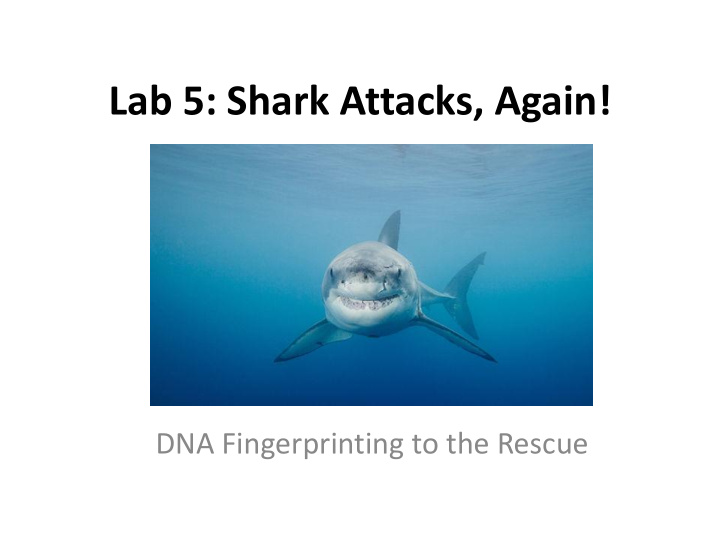



Lab 5: Shark Attacks, Again! DNA Fingerprinting to the Rescue
Notebook Lab Objectives • Develop an understanding of the basic techniques used to study genetic polymorphisms encoded in DNA • Gain familiarity with Restriction Fragment Length Polymorphisms (RFLPs) and their use in the study of biodiversity • Apply RFLP analysis to genetic fingerprinting and shark identification
Reef Point, Australia
Scenario • Series of shark attacks at a remote Australian surfers’ paradise, Reef Point Beach • Reef Point Bay is a mating point for spotted seals (prey for sharks) • Warmer waters and climate change to blame • Determine whether the attacks were committed by the same shark or more than one through forensic analysis of DNA samples
Shark Facts • Average yearly fatalities from shark attacks worldwide is just 2 • Humans kill approximately 2 million sharks per year
Notebook Materials • 2% agarose gel with Gel Green Nucleic Acid Stain • 1X TBE (Tris-borate EDTA) buffer • 4 shark DNA samples for fingerprinting analysis • 1 tube of DNA molecular weight marker (DNA Ladder) • 6X gel loading dye
Notebook DNA Samples • DNA from Crown Beach ( CB ) – 15 µL • DNA from Doom Cove ( DC ) – 15 µL • DNA from Wave Crest ( WC ) – 15 µL • DNA from Hoppa-Hoppa ( HH ) – 15 µL • DNA Ladder ( LAD ) – 15 µL • 6X Gel Loading Dye ( LD ) – 20 µL
Notebook Procedure • Add 3 µL of 6X Gel Loading Dye ( LD ) to each DNA sample (including the DNA Ladder) • Mix well by gently tapping the tube on the lab table • Load DNA samples onto the gel, from left to right, as follows: • Run at 125 volts for ~25-30 mins
Notebook Results • Transfer the picture of your gel into your lab notebook
Ladder
Notebook Analysis Questions 1. Why is there more than one DNA band within each sample analyzed? 2. What caused the DNA to become cleaved (broken up) in small fragments? 3. Examine the shark DNA from Crown Beach. How many restriction sites do you think existed within this sample of DNA? (assume a single linear piece of DNA was the starting material)
Notebook Analysis Questions 4. Based on your analysis of the DNA samples, how many sharks were involved in the recent Reef Point attacks? Explain if one or more sharks were involved, and which attacks, if any, may have involved the same shark. 5. What chemical helps make the DNA visible when exposed to UV light? How does it work? 6. Who is Alec Jeffreys? What were his contributions to science?
DNA Fingerprinting • A DNA Fingerprint represents an individual’s unique genetic profile • Analyze variable regions in DNA in order to identify individuals • Scientists usually focus on regions of DNA that are known to typically vary across individuals (VNTRs) • Isolated variable regions of DNA are then separated by size using gel electrophoresis
VNTRs • Variable number of tandem repeats • Highly variable sequences targeted by restriction enzymes in DNA fingerprinting
DNA Fingerprint
Recommend
More recommend